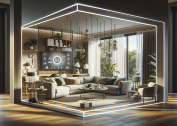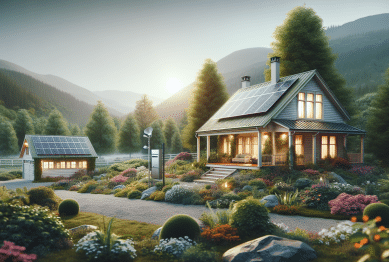Home renovation is no longer just about improving aesthetics—it is about creating spaces that seamlessly combine style and function. As lifestyles evolve, homeowners are seeking solutions that not only elevate the visual appeal of their homes but also enhance practicality, comfort, and efficiency. The trend toward multifunctional and adaptable design has accelerated in recent years, driven by factors such as remote work, sustainability concerns, and advances in smart home technology.
Integrating both style and functionality in a home renovation requires thoughtful planning, informed material choices, and a clear understanding of how spaces are used. By exploring emerging trends and practical design ideas, homeowners can create interiors that are visually striking while serving everyday needs efficiently.

Why Functionality Matters in Modern Home Renovation
The concept of function-first design has gained prominence as more people prioritize usability alongside aesthetics. Modern home renovations increasingly focus on creating spaces that support daily routines, optimize storage, and improve overall living experience.
Key benefits of integrating functionality into design include:
- Enhanced comfort: Thoughtfully designed layouts improve flow and convenience.
- Maximized space: Creative storage solutions help declutter and optimize living areas.
- Increased home value: Homes that balance style and utility tend to attract buyers and appraisers.
- Sustainability: Efficient designs often reduce energy and material waste, supporting eco-conscious living.
According to Houzz’s 2023 Renovation Trends Report, 65% of homeowners now consider both style and functionality equally important when planning renovations (Houzz, 2023).
Kitchen Renovations That Marry Style and Function
The kitchen remains the most frequently renovated space in a home, and modern trends reflect the balance of aesthetics and usability.
Practical and stylish kitchen renovation ideas include:
- Open shelving with hidden storage: Open shelving adds visual interest, while integrated cabinets keep clutter out of sight.
- Multifunctional islands: Kitchen islands that include storage, seating, and prep space increase versatility.
- Smart appliances: Energy-efficient, connected appliances streamline cooking while adding a modern look.
- Durable yet stylish surfaces: Quartz and recycled composite countertops offer long-lasting functionality without sacrificing design appeal.
- Task lighting and ambient lighting: Layered lighting solutions enhance functionality and highlight design features.
The National Kitchen & Bath Association (NKBA) reports that 48% of kitchen remodels now feature multifunctional layouts, reflecting a growing focus on both style and utility (NKBA, 2023).
Living Room Renovation Ideas for Adaptable Spaces
Living areas serve multiple purposes, from entertaining guests to providing quiet spaces for relaxation or work. Renovations in this area increasingly focus on adaptability without compromising style.
Innovative ideas include:
- Modular furniture: Pieces that can be rearranged or expanded as needed improve flexibility.
- Hidden storage solutions: Ottoman benches, built-in shelving, and storage walls keep clutter contained.
- Smart home integration: Automated lighting, sound, and temperature controls enhance comfort and efficiency.
- Accent walls and textures: Combining visually striking elements with functional storage or seating creates dynamic spaces.
As noted in Architectural Digest, multifunctional living spaces are becoming a standard expectation for homeowners, particularly in urban settings where square footage is limited (Architectural Digest, 2023).
Bedroom Renovations That Optimize Comfort and Organization
Bedrooms are increasingly designed to be both restful and highly organized, reflecting modern needs for calm, clutter-free environments.
Practical design ideas include:
- Built-in wardrobes with customizable compartments: Improve storage efficiency while maintaining a clean look.
- Under-bed storage solutions: Utilize often-overlooked spaces for seasonal items or extra bedding.
- Soft lighting and acoustic enhancements: Layered lighting and soundproofing improve comfort and relaxation.
- Multipurpose furniture: Fold-out desks or reading nooks transform bedrooms into versatile retreat areas.
The trend toward multifunctional bedrooms is especially popular among remote workers and families seeking to maximize home utility without compromising style.
Bathroom Renovations That Prioritize Efficiency and Style
Bathrooms are no longer purely functional—they are becoming spa-like retreats with thoughtful design. Balancing utility and aesthetics is key in modern bathroom renovations.
Key ideas include:
- Walk-in showers with integrated shelving: Combines sleek design with practical storage.
- Floating vanities: Enhance visual space while providing accessible storage.
- Water-saving fixtures: Modern faucets, showerheads, and toilets reduce consumption while maintaining comfort.
- Neutral palettes with accent textures: Durable materials like porcelain tiles or natural stone combine elegance and longevity.
According to the American Society of Interior Designers, homeowners increasingly invest in bathrooms that integrate functionality and luxury, with 54% prioritizing efficient design alongside aesthetics (ASID, 2022).
Incorporating Technology for Smart and Stylish Homes
Emerging smart home technologies are bridging the gap between style and function. Home renovations now often integrate devices and systems that enhance convenience, security, and energy efficiency.
Examples include:
- Smart thermostats and lighting: Allow precise control while complementing modern interior designs.
- Voice-activated assistants: Manage tasks and entertainment hands-free.
- Home automation for security: Smart locks and surveillance integrate seamlessly with contemporary decor.
- Energy monitoring systems: Track usage to optimize efficiency and reduce costs.
Smart home adoption has increased rapidly, with the Consumer Technology Association reporting a 34% year-over-year growth in smart home device installations (CTA, 2023).
Key Trends in Modern Home Renovation
Current trends show a strong focus on sustainable, adaptable, and personalized spaces. Notable trends include:
- Eco-conscious materials: Bamboo, reclaimed wood, and recycled composites are increasingly popular.
- Flexible layouts: Open-plan spaces that can be easily reconfigured for work, play, or relaxation.
- Minimalist design: Clean lines and uncluttered spaces combine aesthetics with functionality.
- Integrated storage solutions: Concealed and multifunctional storage continues to be a top priority.
These trends reflect a growing emphasis on long-term value, sustainability, and practical living in home renovation projects.
Conclusion
Home renovation today is about creating spaces that are both visually appealing and highly functional. From kitchens and living rooms to bedrooms and bathrooms, thoughtful design choices can transform homes into efficient, comfortable, and stylish environments. By integrating multifunctional furniture, smart technologies, and eco-conscious materials, homeowners can achieve spaces that meet modern lifestyle needs. Balancing style with utility ensures that renovations not only enhance beauty but also improve daily living, making every room more adaptable, comfortable, and future-ready.
References
- Houzz. (2023). 2023 Renovation Trends Report. https://www.houzz.com/magazine
- National Kitchen & Bath Association (NKBA). (2023). Kitchen Remodeling Insights. https://www.nkba.org/
- Architectural Digest. (2023). Multifunctional Living Spaces. https://www.architecturaldigest.com/
- American Society of Interior Designers (ASID). (2022). Bathroom Design Trends. https://www.asid.org/resources
- Consumer Technology Association (CTA). (2023). Smart Home Technology Growth Report. https://www.cta.tech/









